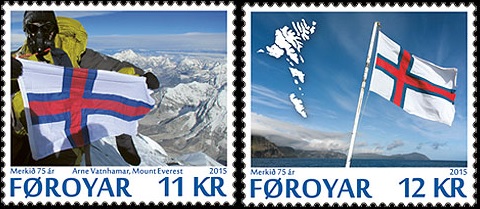
Merkið (The Symbol) – 75th Anniversary of The Faroese National Flag Blue as the sky, red as blood, white as waterfall, surf and winter’s sounds. Merkið – The Student Flag In the era of national awakening in the Faroe Islands, which started at the famous Christmas meeting in 1888, the need for a unifying symbol arose. For a party held in “Føroyingafelag” in Copenhagen 2 March 1919, the students got a girl by the name of Ninna Jacobsen to sew a table model of the flag. They brought this flag to a flag factory in Copenhagen and made a table model for each one of them. The flag was well received among the Faroese in Copenhagen – and later Lisberg went back to the flag factory and got them to sew a full size banner. He brought it to the dormitory “Regensen”, the home of Emil Joensen, the fourth student mentioned in connection with the flag. They hung the flag out of the window in Joensen’s room, cheered on by Icelandic students who also lived at the dorm. Thus, “Regensen” became the place where the Faroese flag was flying for the first time.
In the summer of 1919 Jens Oliver Lisberg travelled to the Faroe Islands bringing with him the Student Flag, as it was then called back then. His plan was to ask Parliament to recognize it as a national flag but he did not succeed for various reasons. But back in his hometown, Fámjin, the flag was hoisted that very summer – for the first time on Faroese soil. Lisberg left the flag back home when he returned to Denmark – and this, the first Faroese flag, is now on display in Famjin’s church. On August 31 1920, Jens Oliver Lisberg died in Copenhagen of the Spanish flu and did not live to see how the flag was gradually accepted by his fellow countrymen.
Throughout the twenties, the Faroese began to accept the “Student Flag” as a national banner. It was named “Merkið” (banner/symbol) and was especially popular among sailors. More and more ships and boats started sailing under “Merkið” and it also became more common ashore on special occasions. This inevitably led to controversy. People wanted “Merkið” recognized as a national flag, while the Danish authorities resisted. In 1938 the Danish representative, prefect Hilbert, suggested in vain that Denmark should recognize the flag.
The final recognition came in April 1940 when communications between the Faroes and Denmark were interrupted due to Germany’s occupation of Denmark. A few days later, the Faroe Islands were formally occupied by Great Britain. Faroese ships sailing under Danish flag with the name DENMARK painted on the sides gave rise to problems. The British Admiralty demanded that Faroese vessels use another flag, either “Merkið” or “Union Jack” – and have the name “Faroes” painted on the sides.
In the days that followed, confusion and controversy arose in the Faroes concerning the matter, ending with Mason, the British consul, deciding on April 25 1940 that all Faroese fishing- and cargo ships were to sail under the Faroese flag and have FAROES – FØROYAR painted on their sides.
As the war progressed the Faroese flag became the standard of the Faroese fleet. In 1947, April 25 was proclaimed the Faroese Flag Day – and at the introduction of the Home Rule in 1948, “Merkið” was officially declared the national flag of the Faroes.
Issue Date: 24.04.2015 Designer: A. Vatnhamar / Andrea Ricordi Printer: Cartor Security Printing, France Process: Offset Colours: 4 Colours Size: 30 mm x 40 mm Values: 11.00, 12.00 kr
